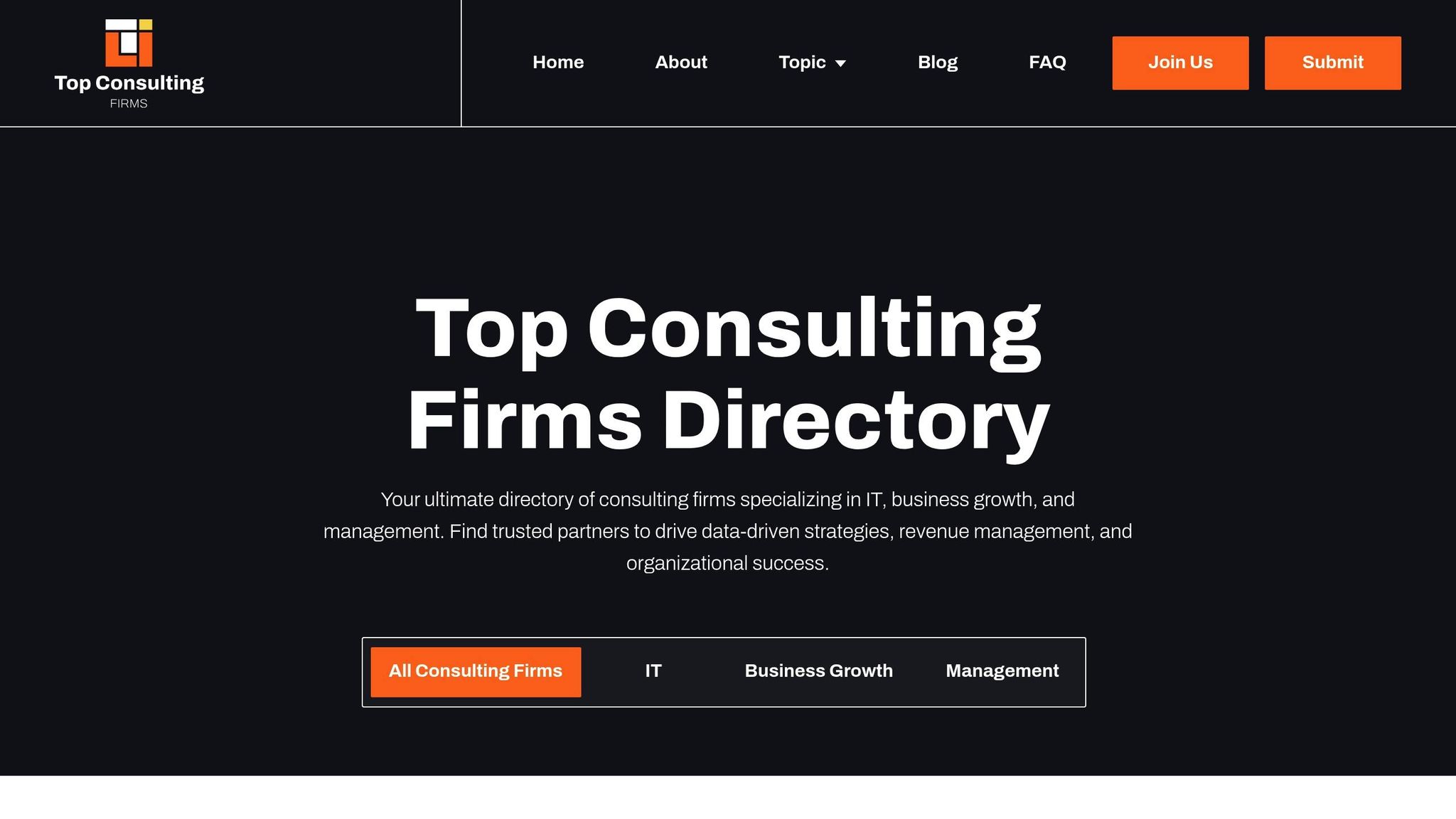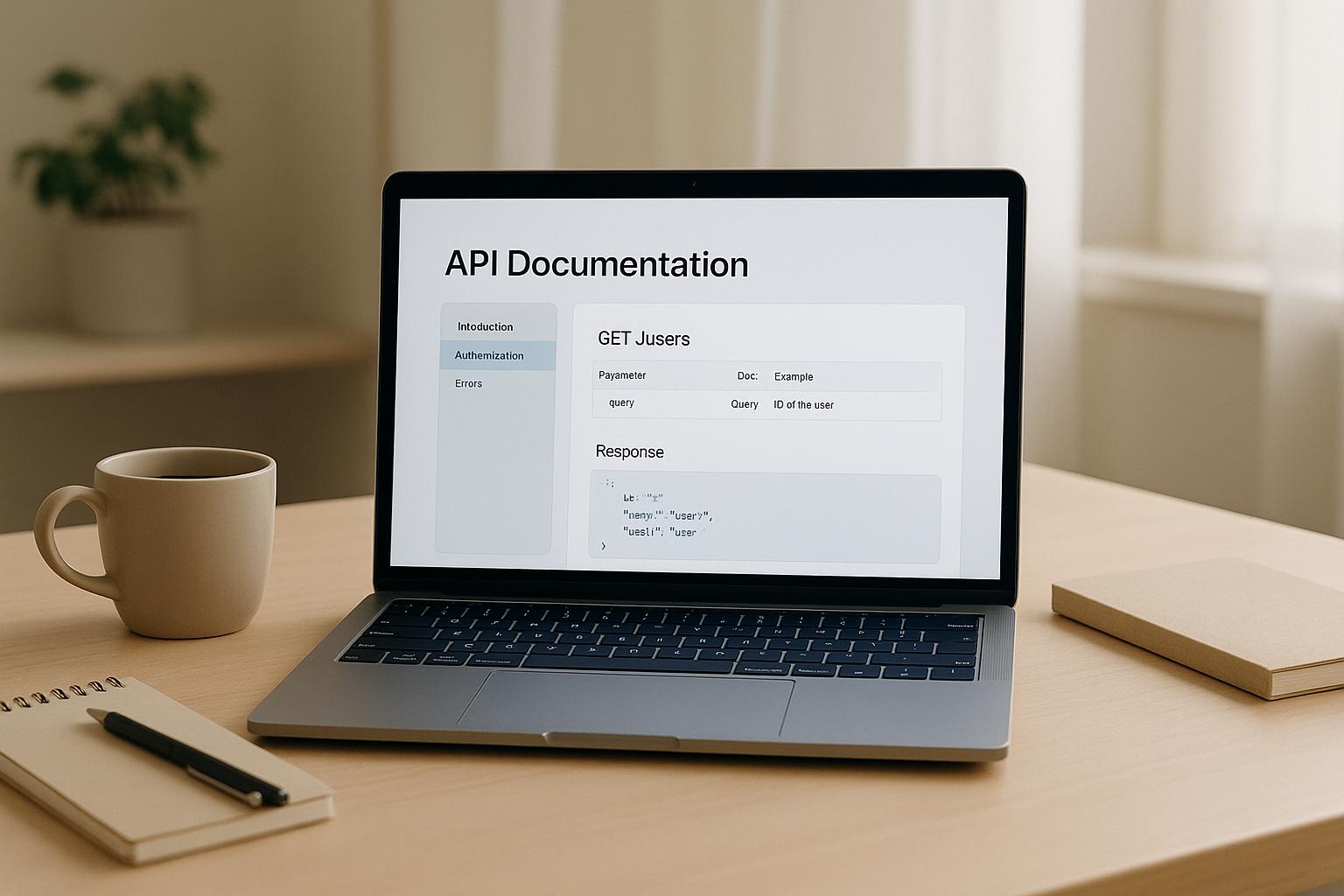Positioning frameworks are essential for businesses to define how their brand is perceived by the target audience. They guide messaging, pricing, and customer experience to ensure consistency and differentiation in competitive markets like the U.S. Here's what you need to know:
-
What is a Positioning Framework?
A strategic guide outlining how your brand stands out, answering questions like:- What makes your business different?
- Why should customers choose you?
- What value do you deliver?
-
Why It’s Important:
In the crowded U.S. market, where consumers face endless choices, a clear framework helps businesses:- Avoid inconsistent messaging
- Stand out from competitors
- Align internal teams on brand identity
-
Key Steps to Build One:
- Research your audience and competitors.
- Set clear goals for brand positioning.
- Choose a strategy (e.g., benefit-based, price-based).
- Write a concise positioning statement.
- Test and refine your messaging regularly.
-
Popular Frameworks:
- STP Model: Segment, target, and position for specific audience needs.
- Perceptual Mapping: Visualize how your brand compares to competitors.
- Value Mapping: Connect product features to customer problems and outcomes.
-
Working with Experts:
Consultants can streamline the process by providing research, tailored strategies, and actionable plans. Use resources like the Top Consulting Firms Directory to find specialists.
A strong positioning framework ensures your brand resonates with your audience, stays competitive, and drives growth.
What Are Some Useful Frameworks For Brand Positioning? - BusinessGuide360.com

Requirements Before Building a Positioning Framework
Before diving into creating your positioning framework, it's important to lay a solid foundation. This means gathering essential information and ensuring your entire team is on the same page. Doing so strengthens the framework and ensures it performs effectively in real-world scenarios.
Know Your Target Audience
Understanding your audience is the cornerstone of a successful positioning framework. Without this insight, your messaging might miss the mark entirely.
"Knowing your audience is essential for effective branding. Identify who your ideal customers are, what their needs are, and what influences their choices. Understanding their values and pain points allows you to craft messages that truly connect with them."
– Sarah McRae, Content Writer, ITVibes
Start by collecting detailed demographic information about your customers. Where do they live? How old are they? What's their income level, and what stage of life are they in? For example, are you speaking to eco-conscious millennials in cities or older suburban buyers who prioritize reliability and service?
Next, look at their buying habits. What drives their decisions? Are they methodical researchers who scour the internet before making a purchase, or do they tend to buy on impulse? Knowing this helps you position your brand at the exact moments they’re most likely to engage.
Don’t stop there - dig into their challenges and unmet needs. What problems are they trying to solve? Or better yet, what solutions are they not even aware they need? This perspective can help uncover opportunities your competitors might have overlooked.
To gather this information, use a mix of methods. Surveys, interviews, and focus groups with current customers are great starting points. Social media conversations and online reviews can also reveal what people love - or wish was different - about your competitors. These insights will help you craft messaging that resonates deeply with your audience.
Once you have a clear understanding of your audience, it’s time to look outward at the market to find your unique place.
Analyze Your Market and Competitors
Your positioning framework doesn’t exist in isolation - it’s shaped by the competitive and market landscape. A thorough analysis of your competitors and industry trends is essential to identify where your brand fits.
Begin by studying your competitors in detail. Look at their messaging, pricing, target demographics, and overall brand identity. This means diving into their websites, social media, ads, and customer feedback. Identify what they do well and, just as importantly, where they fall short.
Market gaps and underserved groups are areas to focus on. These could be based on geography, age, or lifestyle, offering opportunities for your brand to stand out. Tools like perceptual mapping can help you visualize how brands compare on factors such as price versus quality or innovation versus reliability. This can reveal where your brand has room to shine.
Remember, competitors aren’t always direct. For instance, if you’re launching a meal kit service, your competition might include grocery stores, restaurants, and food delivery apps. Keeping an eye on broader trends - like shifts in technology or changes in consumer spending - will also help refine your approach.
Once you’ve analyzed the external market, it’s time to ensure your internal teams are ready to act on these insights.
Get Internal Teams Aligned
Building a positioning framework isn’t a one-person job - it requires input and collaboration from across your organization. Start by identifying key stakeholders from departments like marketing, sales, product development, customer service, and leadership. These are the people who will help turn your framework into action.
Hold alignment workshops to introduce the framework and its purpose. These sessions are crucial for ensuring everyone understands not just what the positioning is but why it matters and how it influences their work. For instance, sales teams need to know how to communicate the positioning to prospects, while customer service teams should use it to guide their interactions.
At this stage, resource planning becomes critical. Updating marketing materials, website content, sales decks, and even product features often requires time, budget, and manpower. Make sure these resources are in place to roll out the framework smoothly.
Finally, establish clear guidelines to maintain consistency across all channels. This includes creating style guides, messaging templates, and approval processes. Regular training sessions and open communication will keep everyone aligned as the framework evolves with market feedback and your business grows.
How to Build a Positioning Framework: 5 Steps
Once you've done your research and aligned your team, it's time to create a positioning framework. This five-step process takes your findings and turns them into a clear, actionable strategy. Each step builds on the last, helping you connect with your audience while standing out in the market.
Step 1: Research Your Market and Audience
Market research lays the foundation for your positioning framework. This step expands on your initial audience analysis with more detailed data.
Start by conducting interviews and surveys to understand why your customers make purchasing decisions. Ask about their decision-making process, the challenges they face, and what might make them switch to a new solution. Pay close attention to the exact words and phrases they use - this language will be key for crafting your messaging.
For secondary research, dive into industry reports, market trends, and consumer behavior studies. Look for changes in technology, customer preferences, or regulations that might open up new opportunities. Resources like the U.S. Census Bureau or industry groups can provide helpful data on demographics and spending habits.
Use competitive intelligence tools to keep tabs on your rivals. Monitor their messaging, pricing strategies, and customer reviews. Social listening platforms can uncover what people are saying about competitors online, often revealing unmet needs or frustrations that you can address.
Build detailed customer personas from your research. Go beyond basic demographics and include psychographics - things like values, attitudes, and lifestyle choices. For B2B companies, map out the buying process and identify key decision-makers and influencers.
Document everything in a central repository that your team can easily access. This ensures your positioning framework is built on real data, not assumptions.
Step 2: Set Your Positioning Goals
Define measurable goals to guide your positioning efforts and evaluate their success. These goals should address the market gaps and customer behaviors identified in your research, while aligning with your broader business objectives.
Brand differentiation goals might focus on increasing recognition, shifting perceptions, or establishing authority in your field. For instance, if customers see your brand as outdated, your goal could be to reposition it as modern and forward-thinking.
Market share objectives could include capturing a specific segment or expanding into new customer groups. Be specific - rather than saying "increase market share", aim for something like "capture 15% of the premium segment within 18 months."
Revenue goals should tie directly to your positioning strategy. If you're positioning as a premium brand, focus on boosting average order value. If you're targeting affordability, prioritize customer acquisition.
Don't forget about defensive goals, like retaining existing customers or protecting market share from new competitors.
Set both short-term (3-6 months) and long-term (12-24 months) objectives. Short-term goals might focus on building awareness, while long-term goals track outcomes like revenue growth or market share.
Keep your goals realistic. Overly ambitious targets can lead to strategies that feel forced or unsustainable.
Step 3: Pick Your Positioning Strategy
Your positioning strategy defines how you'll differentiate your brand and what message you'll bring to the market. The best strategy depends on your competition, customer needs, and your business strengths.
- Benefit-based positioning highlights the main advantage your product or service offers. This works well if you have a clear functional or emotional benefit that resonates with your audience, like improved security or increased productivity.
- Price-based positioning focuses on cost. This doesn't always mean being the cheapest - you could position yourself as the best value, the premium choice, or the most cost-effective for specific needs.
- Competitor-based positioning involves directly comparing your brand to others. This could be through direct claims like "faster than X" or by creating a new category, like "the first Y designed for Z."
- User-based positioning targets a specific customer group or use case. By focusing on a particular type of customer, you can build loyalty and encourage word-of-mouth referrals.
- Attribute-based positioning emphasizes specific product features, like quality, reliability, or innovation. Choose attributes that matter to your audience and that your business can consistently deliver.
You can combine elements from multiple strategies, but keep your main message simple and focused. A clear, consistent positioning is always more effective than one that's scattered or confusing.
Step 4: Write Your Positioning Statement
Your positioning statement serves as a blueprint for all your messaging. It should clearly and concisely capture how you want your brand to be perceived.
A common format is: "For [target customer], [brand name] is the [category] that [key benefit] because [supporting reasons]." While this structure is helpful, you can adapt it as needed - what matters most is clarity.
- Target customer: Be specific. Instead of "small businesses", try "growing service businesses with 10-50 employees who struggle with manual processes."
- Category definition: Help customers understand how your brand fits into their mental map of solutions. Whether you're part of an existing category or creating a new one, make it easy to grasp.
- Key benefit: Address the most important need or desire of your audience. Focus on outcomes, not just features.
- Supporting reasons: Back up your claims with evidence, like unique features, proprietary technology, or team expertise.
Test your positioning statement internally first. Does it reflect your capabilities? Can your team deliver on its promise? Then, share it with customers to ensure it resonates and makes sense.
Refine your statement until it feels clear, compelling, and realistic. Remember, this is mainly an internal tool - external messaging will adapt the core positioning for different audiences and platforms.
Step 5: Test and Improve Your Messaging
Testing helps you validate your positioning and identify areas for improvement. It can save you time and resources by catching issues early.
- Concept testing: Share your positioning with target customers through surveys or focus groups. Look for feedback on clarity and relevance. Pay attention to the words they use, as this can help refine your messaging.
- A/B testing: Experiment with different elements of your positioning, like benefit statements or target audience definitions, to see what resonates most.
- Message testing: Evaluate how your positioning translates into specific marketing materials, like headlines, product descriptions, or sales pitches. Adjust as needed for different contexts.
- Competitive response testing: Present your positioning alongside competitors' messages to see which stands out. This can reveal both strengths and weaknesses in your approach.
Gather both quantitative data (like purchase intent scores) and qualitative feedback (like open-ended comments). Use this input to refine your positioning and messaging.
Keep testing on a regular schedule. Positioning isn’t static - customer needs and market conditions evolve, and your strategy should too. Regular updates ensure your positioning stays relevant and effective.
sbb-itb-97f6a47
Popular Positioning Frameworks and When to Use Them
Positioning frameworks are not one-size-fits-all - they depend heavily on your business goals and market landscape. Below are three tried-and-tested approaches tailored for the U.S. market. Each offers distinct advantages, so pick the one that aligns best with your strategy and product.
STP Model (Segmentation, Targeting, Positioning)
The STP model breaks your market into segments, identifies the most promising ones, and tailors your positioning to meet their specific needs. This framework is a great fit for crowded markets or when launching a new product.
- Segmentation: This step divides your market into groups based on factors like demographics, behavior, or needs. For example, a fitness app might segment users into busy professionals, stay-at-home parents, and college students.
- Targeting: Here, you decide which segments to prioritize. Look for groups that are large enough to generate revenue, underserved by competitors, and aligned with your company’s strengths. The goal is to focus on areas where you can genuinely compete and win.
- Positioning: Finally, craft messaging that resonates with your chosen audience. Highlight how your product meets their needs better than alternatives.
This model is particularly effective for consumer brands in competitive spaces. It helps you avoid trying to appeal to everyone, which often leads to diluted messaging. Netflix is a prime example - they use this approach to tailor offerings for different groups, such as families seeking kid-friendly content or young adults drawn to original series.
Perceptual Mapping
Perceptual mapping offers a visual way to understand how customers view your brand compared to competitors, making it easier to spot opportunities or gaps in the market.
To start, choose two attributes that matter most to your audience - such as price versus quality, or convenience versus innovation. Survey your target audience to see how they rate various brands on these attributes, then plot the results on a two-axis graph.
This map reveals your brand’s current position, areas of market saturation, and potential niches to explore.
Perceptual mapping is especially helpful when you have clear competitors and well-defined product attributes. It’s often used by established brands looking to reposition or by new brands trying to carve out a unique space. For example, in the U.S. automotive market, luxury carmakers often position themselves in the high-price, high-quality quadrant, while brands like Toyota dominate the reliable, affordable space. Tesla, on the other hand, created a new position by blending luxury with environmental consciousness.
Value Mapping for Complex Products
Value mapping is perfect for B2B, software, and other complex products. It connects your product’s features to customer problems and the outcomes they care about most.
To build a value map, create three columns:
- Customer Problems: List the challenges your audience faces.
- Product Features: Match each problem to a specific feature of your product.
- Benefits/Outcomes: Translate each feature into a measurable result, like "reduces processing time by 40%."
This process not only highlights which benefits to emphasize in your messaging but also helps identify features that don’t address real customer needs. For example, focus on the outcomes that solve your audience’s most pressing challenges or deliver the greatest value.
Value mapping is particularly useful for enterprise software and technical products, where decision-makers prioritize results over technical specs. To make this framework work, spend time understanding your customers’ workflows and pain points. Observe how they currently solve problems and identify where your product fits in. This hands-on understanding makes your positioning more relatable and impactful.
Each of these frameworks offers a structured way to refine your positioning, helping you stand out in your market and connect with your audience more effectively.
Working with Consultants on Positioning Frameworks
Creating a strong positioning framework can feel like a juggling act, especially when you're managing competing priorities. That’s where expert guidance can make all the difference. Many U.S. companies turn to consulting firms to tap into specialized knowledge that not only speeds up the process but also helps refine strategies for better outcomes. This approach is particularly effective for businesses entering new markets or rethinking their brand positioning.
How Consulting Firms Make a Difference
Consulting firms bring an outsider's perspective and a wealth of expertise that internal teams may not always have. Their wide-ranging industry experience helps uncover opportunities and spot risks that might be overlooked by those working within the organization.
One of their key strengths lies in market research and data analysis. Equipped with advanced tools, comprehensive databases, and proven methodologies, consultants can handle tasks like competitor analysis, customer surveys, and market segmentation studies with efficiency and precision - often outperforming in-house teams in these areas.
When it comes to choosing the right positioning framework, consultants rely on their experience to recommend approaches tailored to your specific needs. Whether it’s the STP framework for consumer brands, perceptual mapping for established companies, or value mapping for complex B2B products, their expertise ensures that your strategy aligns with your industry, competition, and goals.
But it doesn’t stop at strategy. Consultants go a step further by turning positioning plans into actionable marketing messages, sales tools, and internal communication strategies. They also train teams to consistently apply the framework across all customer interactions, ensuring that the strategy isn’t just theoretical but actually delivers measurable results.
Another major advantage? Speed. Thanks to their established processes and focused project teams, consultants can often deliver results much faster than if you were to develop a positioning framework in-house.
If you’re looking for experts to guide you, a reliable directory can help streamline the search.
Finding Experts Through Top Consulting Firms Directory

The real challenge isn’t finding consulting firms - it’s finding the right ones with the skills and experience to handle positioning frameworks effectively, especially in the context of U.S. market dynamics. That’s where the Top Consulting Firms Directory comes in. It’s a curated resource designed to connect businesses with consultants who specialize in strategic positioning, market expansion, and related areas.
This directory provides access to a vetted list of firms with proven expertise in strategic management and positioning projects. Many of these consultants also bring experience in areas like digital transformation and revenue growth, which often tie closely to positioning work.
When evaluating potential partners, focus on their industry experience and track record with similar projects. Don’t hesitate to ask about their approach, expected timelines, and how they define success. The best consultants will take the time to understand your business and offer solutions tailored to your needs.
Of course, costs will vary depending on the scope of the project and the firm’s expertise. To ensure value for your investment, it’s critical to set clear goals and realistic timelines from the outset. The right partnership can lead to sharper marketing strategies, better customer acquisition, and a stronger competitive edge.
Conclusion
A well-crafted positioning framework is more than just a strategy - it's the foundation of how your brand connects with customers. In this guide, we’ve covered everything from understanding your audience and analyzing competitors to setting clear goals, choosing the right strategies, and refining through ongoing testing.
As markets shift, your positioning strategy should adapt too. Leading companies in the U.S. approach positioning as a continuous process. Whether you opt for the STP model to segment your audience, perceptual mapping to visualize your competitive landscape, or value mapping for navigating complex B2B markets, the secret lies in applying your framework consistently across every customer touchpoint.
Internal alignment is equally important. Every interaction a customer has with your brand should reflect the same message and values. This consistency strengthens trust and fosters long-term growth.
For businesses tackling complex positioning challenges, expert guidance can make all the difference. Professional consultants bring valuable tools, tested methodologies, and an unbiased perspective that internal teams might lack. They can help you avoid common mistakes and ensure your framework delivers real, measurable outcomes.
Looking for help? The Top Consulting Firms Directory is a great resource for finding U.S.-based positioning experts. The right partnership can turn your positioning framework into a competitive edge, driving customer acquisition and boosting revenue.
FAQs
How can I choose the best positioning strategy for my business in a competitive market?
To choose the right positioning strategy for your business, begin with a deep dive into your market and competitors. Pinpoint what sets your business apart - your unique value proposition - and how it directly addresses your customers' needs. This clarity is key to creating messages that truly connect with your audience.
From there, take a close look at your core strengths and how they distinguish you from others in the market. Build your strategy around these strengths, ensuring they shine through in your branding and outreach efforts. By combining detailed market research, competitor insights, and clear communication of your value, you'll be better equipped to carve out a strong position in a crowded marketplace.
What are the best ways to gather insights about my target audience for creating a strong positioning framework?
To create a solid positioning framework, start by diving deep into your audience's world. Use tools like surveys, focus groups, and interviews to uncover what drives them - their preferences, challenges, and motivations.
Next, tap into analytics tools to track customer behavior. Look at website activity, purchase trends, and how they interact on digital platforms. This data can uncover patterns and point out areas where you can improve.
Lastly, develop detailed buyer personas by grouping your audience based on demographics, interests, and behaviors. This step ensures your positioning speaks directly to their needs and expectations, giving you a clear path toward success.
How can consulting firms help create and implement an effective positioning framework for my brand?
Consulting firms are instrumental in shaping and implementing a positioning framework. They utilize tools like market research, competitive analysis, and differentiation strategies to pinpoint your brand’s unique value and ensure it resonates with the right audience.
Beyond the initial setup, these firms offer expert advice to keep your positioning fresh and aligned with evolving market trends or changing customer preferences. Regular updates and adjustments to your framework ensure it stays effective. This approach not only reinforces your brand’s identity but also supports sustained growth and long-term success.


